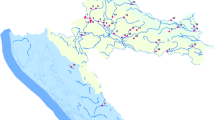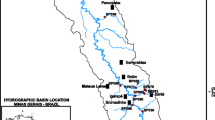Abstract
A multi-residue analysis method was developed for the determination of penicillins in wastewater of WWTP, surface water and groundwater in Spain. The procedure involves a solid phase extraction (SPE) and the subsequent analysis by liquid chromatography coupled to tandem mass spectrometry detection (LC-QqQ-MS/MS). The SPE processes were optimized by test of cartridges, sample pH and elution solvents. ENV+ cartridge was chosen for the extraction of penicillins from different environmental samples. The best conditions for the extraction efficiency of the targets were observed at sample pH 6, by eluting solvents of methanol and acetonitrile respectively. The method has been validated by calibration curve, corresponding regression coefficient, limit of quantification and recoveries. The results showed that the recoveries of more than 90 % were presented in all the compounds, except AMOX and AMPI, which had special amino-group in the molecular structure different with others. The matrix effect was also considered in the experiment and it was concluded that different matrix effect could be found between three kinds of waters, and the low retention of AMOX and AMPI on the cartridges was attributed to the matrices interference. The real sample detection showed that the penicillins degraded fast and only AMOX appeared in the studied environmental samples. The results of toxicology test on two compounds (AMOX and AMPI) showed that bacteria V. fischeri was proved to be relatively insensitive to both targets. The decreasing order of toxicity in three environmental waters for AMOX and AMPI was: wastewater > groundwater > surface water.






Similar content being viewed by others
References
Angelina LG, Patrizia C, Vivia B (2013) Response of bacterial isolates from Antarctic shallow sediments towards heavy metals, antibiotics and polychlorinated biphenyls. Ecotoxicol 22:240–250
Bailón-Pérez MI, García-Campaña AM, Cruces-Blanco C, del Olmo Iruela M (2008) Trace determination of β-lactam antibiotics in environmental aqueous samples using off-line and on-line preconcentration in capillary electrophoresis. J Chromatogr A 1185:273–280
Baquero F, Martĺnez J-L, Cantón R (2008) Antibiotics and antibiotic resistance in water environments. Curr Opin Biotechnol 19:260–265
Benito-Peña E, Partal-Rodera AI, León-González ME, Moreno-Bondi MC (2006) Evaluation of mixed mode solid phase extraction cartridges for the preconcentration of beta-lactam antibiotics in wastewater using liquid chromatography with UV-DAD detection. Anal Chim Acta 556:415–422
Bi PY, Dong HR, Guo QZ (2009) Separation and Purification of Penicillin G from fermentation broth by solvent sublation. Sep Purif Technol 65:228–231
Castiglioni S, Bagnati R, Calamari D, Fanelli R, Zuccato E (2005) A multiresidue analytical method using solid-phase extraction and high-pressure liquid chromatography tandem mass spectrometry to measure pharmaceuticals of different therapeutic classes in urban wastewaters. J Chromatogr A 1092:206–215
Cha JM, Yang S, Carlson KH (2006) Trace determination of β-lactam antibiotics in surface water and urban wastewater using liquid chromatography combined with electrospray tandem mass spectrometry. J Chromatogr A 1115:46–57
Christen V, Hickmann S, Rechenberg B, Fent K (2010) Highly active human pharmaceuticals in aquatic systems: a concept for their identification based on their mode of action. Aquat Toxicol 96:167–181
Christian T, Schneider RJ, Farber HA, Skutlarek D, Meyer MT, Goldbach HE (2003) Determination of antibiotics residuals in manure, soil, and surface wate. Acta Hydroch Hydrob 31:36–44
Daughton CG, Ternes TA (1999) Pharmaceuticals and personal care products in the environment: agents of subtle change. Environ Health Perspect 107:907–938
Escher BI, Baumgartner R, Koller M, Treyer K, Lienert J, Mcardell CS (2011) Environmental toxicology and risk assessment of pharmaceuticals from hospital wastewater. Water Res 45:75–92
Fatta D, Nikolaou A, Achilleos A, Meric S (2007) Analytical methods for tracing pharmaceutical residues in water and wastewater. Trend Anal Chem 26:515–533
Ferrari B, Paxéus N, Giudice RL, Pollio A, Garric J (2003) Ecotoxicological impact of pharmaceuticals found in treated wastewaters: study of carbamazepine, clofibric acid, and diclofenac. Ecotoxicol Environ Saf 55:359–370
Gottschall N, Topp E, Metcalfe C, Edwards M, Payne M, Kleywegt S, Russell P, Lapen DR (2012) Pharmaceutical and personal care products in groundwater, subsurface drainage, soil, and wheat grain, following a high single application of municipal biosolids to a field. Chemosphere 87:194–203
Hernández F, Sancho JV, Ibáñez M, Guerrero C (2007) Antibiotic residue determination in environmental waters by LC-MS. Trend Anal Chem 26:466–485
Jones OAH, Voulvoulis N, Lester JN (2002) Aquatic environmental assessment of the top 25 English prescription pharmaceuticals. Water Res 36:5013–5022
Kim HY, Lee MJ, Yu SH (2012) The individual and population effects of tetracycline on Daphnia magna in multigenerational exposure. Ecotoxicol 21:993–1002
Kostich M. S, Lazorchak J. M (2008) Risks to aquatic organisms posed by human pharmaceutical use. Sci Total Environ 389:329-339
Kostopoulou M, Nikolaou A (2008) Analytical problems and the need for sample preparation in the determination of pharmaceuticals and their metabolites in aqueous environmental matrices. Trend Anal Chem 27:1023–1035
Kümmerer K (2009) The presence of pharmaceuticals in the environment due to human use—present knowledge and future challenges. J Environ Manage 90:2354–2366
Lapworth DJ, Baran N, Stuart ME, Ward RS (2012) Emerging organic contaminants in groundwater: a review of sources, fate and occurrence. Environ Pollut 163:287–303
Larcher S, Yargeau V (2011) Biodegradation of sulfamethoxazole by individual and mixed bacteria. Appl Microbiol Biotechnol 91:211–218
Li D, Yang M, Hu J, Zhang Y, Chang H, Jin F (2008) Determination of penicillin G and its degradation products in a penicillin production wastewater treatment plant and the receiving river. Water Res 42:307–317
Martins N, Pereira R, Abrantes N (2012) Ecotoxicological effects of ciprofloxacin on freshwater species: data integration and derivation of toxicity thresholds for risk assessment. Ecotoxicol 21:1167–1176
Morley NJ (2009) Environmental risk and toxicology of human and veterinary waste pharmaceutical exposure to wild aquatic host–parasite relationships. Environ Toxicol Pharmacol 27:161–175
Park S, Choi K (2008) Hazard assessment of commonly used agricultural antibiotics on aquatic ecosystems. Ecotoxicol 17:526–538
Porsbring T, Blanck H, Tjellström H, Backhaus T (2009) Toxicity of the pharmaceutical clotrimazole to marine microalgal communities. Aquat Toxicol 91:203–211
Pounds N, Maclean S, Webley M, Pascoe D, Hutchinson T (2008) Acute and chronic effects of ibuprofen in the mollusc Planorbis carinatus. Ecotoxicol Environ Saf 70:47–52
Santos LHMLM, Araujo AN, Fachini A, Pena A, Delerue-Matos C, Montenegro MCBSM (2010) Ecotoxicological aspects related to the presence of pharmaceuticals in the aquatic environment. J Hazard Mater 175:45–95
Tong L, Li P, Wang Y, Zhu K (2009) Analysis of veterinary antibiotic residues in swine wastewater and environmental water samples using optimized SPE-LC/MS/MS. Chemosphere 74:1090–1097
Tong L, Eichhorn P, Pérez S, Wang Y, Barceló D (2011a) Photodegradation of azithromycin in various aqueous systems under simulated and natural solar radiation: kinetics and identification of photoproducts. Chemosphere 83:340–348
Tong L, Pérez S, Gonçalves C, Alpendurada F, Wang Y, Barceló D (2011b) Kinetic and mechanistic studies of the photolysis of metronidazole in simulated aqueous environmental matrices using a mass spectrometric approach. Anal Bioanal Chem 399:421–428
Trovό AG, PupoNogueira RF, Agüera A, Fernandez-Alba AR, Malato S (2011) Degradation of the antibiotic amoxicillin by photo-Fenton process e Chemical and toxicological assessment. Water Res 45:1394–1402
Wang Y, Leung PC, Qian PY (2006) Antibiotic resistance and plasmid profile of environmental isolates of Vibrio species from Mai Po Nature Reserve, Hong Kong. Ecotoxicol 15:371–378
Xia R, Ren Y, Guo X (2013) Molecular diversity of class 2 integrons in antibiotic-resistant gram-negative bacteria found in wastewater environments in China. Ecotoxicol 22:402–414
Acknowledgments
This research was jointly funded by National Natural Science Foundation of China (41103063 and 40830748), Natural Science Foundation of Hubei Province (08Z346), and Science Foundation of Central College (CUGL100217 and CUG 120406).
Conflict of interest
None.
Author information
Authors and Affiliations
Corresponding author
Rights and permissions
About this article
Cite this article
Tong, L., Wang, Y.X., Hermo, M.P. et al. Simultaneous determination and toxicological assessment of penicillins in different water matrices. Ecotoxicology 23, 2005–2013 (2014). https://doi.org/10.1007/s10646-014-1336-1
Accepted:
Published:
Issue Date:
DOI: https://doi.org/10.1007/s10646-014-1336-1




